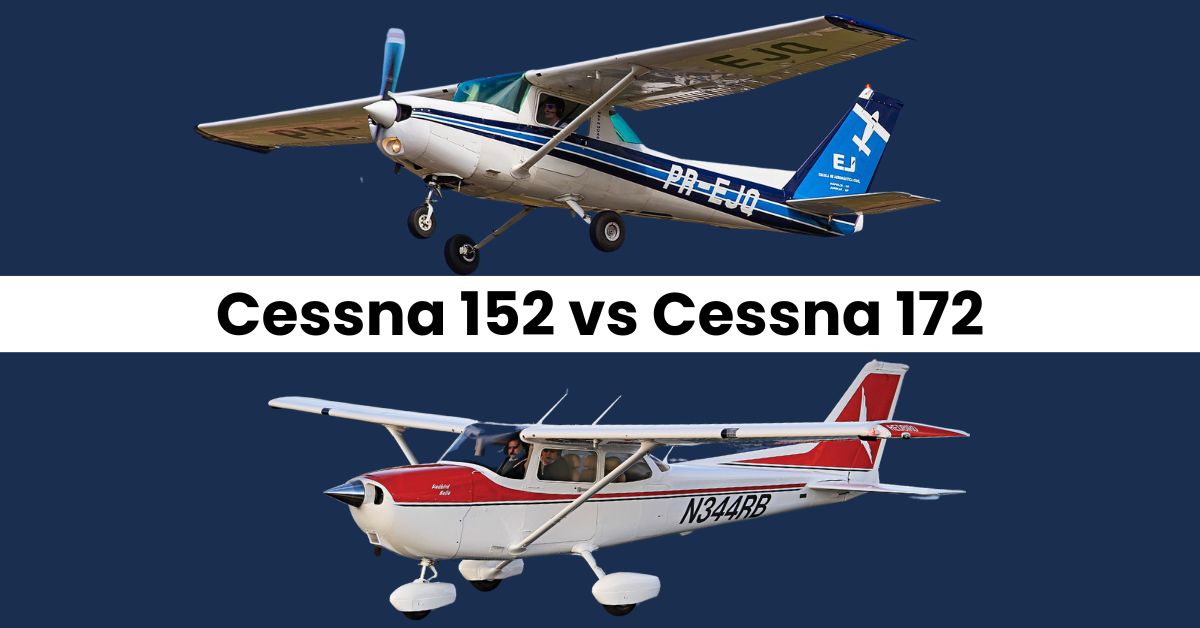The Cessna 152 vs 172, both favored for flight training and personal aviation, stand out as two of the most iconic and widely used aircraft globally. The 152, in particular, is often the go-to choice for those learning to fly, thanks to its affordability compared to the slightly more upscale 172.
The 172, with its remarkable track record of longevity and widespread use, can be considered one of the most successful aircraft ever made.
While these aircraft share several features, notable distinctions include cockpit size, safety records, pricing, and performance metrics. Each has carved out its niche in the aviation community, offering unique benefits to pilots and aviation enthusiasts alike.
Cessna 152 vs 172 Comparison

Comparing the Cessna 152 vs 172 reveals significant differences tailored to specific pilot needs, with a clear distinction in pricing, performance, range, and capacity. The Cessna 152, typically priced between $25,000 and $100,000, offers an economical choice for students and solo pilots, thanks to its efficient fuel burn of around 6 gallons per hour and a modest cruising speed of approximately 107 knots. With a range of about 415 nautical miles and seating for two, it’s perfectly suited for flight training and short solo journeys.
In contrast, the Cessna 172, with prices ranging from $100,000 to $300,000 for various models and conditions, caters to those requiring more from their aircraft. Its Lycoming IO-360-L2A engine, producing 180 horsepower, allows for a fuel burn of 7 to 9 gallons per hour, a cruising speed of up to 124 knots, and a range extending to 640 nautical miles. This four-seater not only accommodates more passengers or cargo but also delivers the performance and comfort needed for longer, more versatile missions. Check out our comparison of the Cessna 150 vs Cessna 172 to see how they differ.
| Specification | Cessna 152 1978/1985 | Cessna 172 |
|---|---|---|
| Engine Model | Lyc. O-235-L2C/N2C | Lycoming IO-360-L2A |
| Horsepower (HP) | 110 | 180 |
| Fuel Capacity (Standard/Long Range Tanks) | 26/39 gallons | 56 gallons (53 gallons usable) |
| Average Fuel Burn at 75% Power | 6.1 gallons (1985 model unknown) | 9.9 gallons per hour |
| Takeoff/Landing Weight (Utility Category) | 1,670 lbs. (1978) / 1,675 lbs. (1985) | N/A |
| Standard Empty Weight | 1,081 lbs. (1978) / 1,109 lbs. (1985) | 1,680 lbs. |
| Max. Useful Load (Utility Category) | 589 lbs. (1978) / 566 lbs. (1985) | 878 lbs. |
| Baggage Capacity | 120 lbs. | 120 lbs., 30 cu ft |
| Service Ceiling | 14,700 ft | 14,000 ft |
| Max. Structural Cruising Speed | 111 KIAS | – |
| Stall Speed (Clean/Landing Configuration) | 48 Knots / 43 Knots | – / 40 KIAS |
| Climb Best Rate | 715 FPM | 730 fpm |
| Wing Loading | 10.5 lbs./sq. ft. | 14.7 lb/sq ft |
| Power Loading | 15.2 lbs./hp (1978) / 15.5 lbs./hp (1985) | 14.1 lb/hp |
| Cruise Speed | – | 124 kt |
| Range | – | 640 nm |
Cessna 152
The first time I laid eyes on a Cessna 152, I knew it was more than just an aircraft; it was the beginning of countless flying adventures. Since its debut in 1977, the Cessna 152 has become a staple in the flight training world, with over 7,500 units produced up until 1985. It’s not just the numbers that make it impressive; it’s the experiences it offers. Powered by a robust Lycoming O-235 engine with 110 horsepower, this trusty two-seater isn’t just about getting from point A to B; it’s about the sheer joy of flying.

What really stands out is its fuel efficiency. On average, the 152 sips fuel at about 6 gallons per hour and has a tank that can carry 26 gallons, extendable to 39 gallons for those who dare to venture further, offering a range of up to 415 nautical miles. This means more time in the air and less time worrying about the next fuel stop. Flying a 152 feels intimate, perfect for one-on-one flight training or a solo jaunt above the clouds. Its cruising speed of 107 knots might not break records, but it guarantees a serene flight every time.
The Cessna 152, along with its aerobatic sibling, the A152 Aerobat, showcases the aircraft’s versatility from basic training to exhilarating aerobatics. Equipped with a 110 horsepower Lycoming O-235 engine, these models offer an affordable yet diverse flying experience. Whether it’s mastering flight fundamentals or performing dynamic loops and rolls, the 152 family turns every flight into an unforgettable adventure, proving itself as a gateway to both aviation basics and the thrill of the skies.
Cessna 172 Skyhawk
From the moment the Cessna 172 Skyhawk first took to the skies in 1956, it has been more than just a plane to me—it’s a symbol of adventure and the boundless freedom found in the clouds. With over 44,000 units crafted, the Skyhawk’s legacy as the most produced aircraft in history speaks volumes of its universal appeal and reliability. At its heart beats a robust Lycoming IO-360-L2A engine, offering 180 horsepower of reliable thrust, making every flight, whether for training purposes or cross-country adventures, a testament to its enduring performance.

The Skyhawk strikes a perfect harmony between fuel efficiency and extended range. Its 56-gallon fuel capacity supports flights of up to 640 nautical miles, marrying economy with the spirit of exploration. This efficiency, coupled with a fuel burn rate of 7-9 gallons per hour, ensures that my flights are as economical as they are exhilarating. Moreover, the spacious cabin is a haven of comfort, welcoming both eager students and loved ones on journeys through the skies.
Throughout its history, the 172 has evolved through variants like the performance-geared 172R and the turbocharged 172S, each adding layers to its storied legacy. But for me, at its core, the Cessna 172 Skyhawk remains an unwavering companion in my aerial adventures. It’s not merely a machine; it’s a vessel of cherished memories, a mentor in the art of flying, and a gateway to exploring the infinite blue. In every takeoff, in every landing, it embodies the pure essence of flying, making every moment airborne a celebration of flight.
Cessna 152 vs 172 Performance
When comparing the performance of the Cessna 152 vs 172, it’s clear that each plane has its own strengths suited for different needs. The Cessna 172 stands out with its higher top speed of 140 mph compared to the 152’s 126 mph, making it the faster of the two. It also boasts a longer range of 696 nautical miles, significantly more than the 152’s 415 nautical miles. This means the 172 can fly further without needing to refuel, making it ideal for longer trips.
Additionally, the 172 can climb to a higher altitude, with a service ceiling of 14,700 feet versus the 152’s 13,500 feet. This higher service ceiling allows pilots to fly over weather and terrain that might require a detour in the 152.
The 172’s larger size not only increases its capacity, allowing it to carry up to four people, but also contributes to its ease of handling, especially noticeable in its lower stall speed of 49 mph compared to the 152’s 54 mph. This makes takeoffs and landings smoother and safer, particularly for less experienced pilots.
Cessna 152 vs 172 Safety
The Cessna 152 vs 172, both are really safe airplanes. However, the Cessna 172 comes out on top because it has a really low chance of accidents – only 0.56 in 100,000 hours of flying, which is one of the best records for any small plane. This impressive safety record is thanks to its strong build, great safety features, predictable flying behavior, and the ability to land slowly and safely because of its good flaps.
On the other hand, the Cessna 152 is also a safe plane but it’s been in more accidents. This is mostly because it’s the go-to plane for learning how to fly, and most accidents happen during this learning period. Many accidents involve problems during takeoff or when flying low, often with new pilots at the controls. But this doesn’t mean the 152 is unsafe; it’s more about the challenges of learning to fly.
Cessna 152 vs 172 Cockpit
The Cessna 152 and 172 offer distinct cockpit experiences due to their size differences. The 152, being smaller, has a more compact cockpit, making it a tight fit for pilots, especially on longer flights. This is why larger pilots often prefer the 172, which boasts a four-seat capacity and provides a more comfortable space for everyone on board. While the 152 necessitates the use of a pilot kneeboard due to its limited space, the 172’s larger cockpit offers a more relaxed flying experience, making it a favorite among pilots who value comfort and space.
Price
Choosing between training in a Cessna 152 vs 172 largely comes down to cost, with the 152 being the more wallet-friendly option. Ideal for student pilots or those entering the flying world on a budget, the Cessna 152 offers a practical and economical path. Prices for a 152 fall between $25,000 and $100,000, varying with its condition and modifications. In contrast, the Cessna 172, offering more space and capability, commands a higher price range of $100,000 to $300,000. Whether you’re aiming to learn to fly or buy your own plane, the 152 presents a cost-effective entry into aviation, making it an attractive choice over the 172 for cost-conscious aspiring pilots.
Summary
The Cessna 152 and 172 each hold a revered place in the world of aviation, offering distinct advantages tailored to different needs and preferences. The 152, with its affordability and simplicity, serves as an excellent entry point for those new to flying. It’s the go-to aircraft for flight training, providing a solid foundation for pilots in training. The 172, meanwhile, expands the horizon with its enhanced performance, greater capacity, and comfort, making it perfect for longer flights and more passengers. Choosing between the two ultimately depends on your specific flying goals, budget, and the type of experience you seek in the skies.
FaQs
Which is more affordable for flight training, the Cessna 152 or 172?
Can the Cessna 172 carry more passengers than the 152?
Which aircraft is better for cross-country flights?
Are both the Cessna 152 and 172 safe for beginners?
How does the cockpit size compare between the two aircraft?



